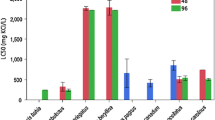Abstract
Assessment of contaminant impacts to federally identified endangered, threatened and candidate, and state-identified endangered species (collectively referred to as “listed” species) requires understanding of a species’ sensitivities to particular chemicals. The most direct approach would be to determine the sensitivity of a listed species to a particular contaminant or perturbation. An indirect approach for aquatic species would be application of toxicity data obtained from standard test procedures and species commonly used in laboratory toxicity tests. Common test species (fathead minnow, Pimephales promelas; sheepshead minnow, Cyprinodon variegatus; and rainbow trout, Oncorhynchus mykiss) and 17 listed or closely related species were tested in acute 96-hour water exposures with five chemicals (carbaryl, copper, 4-nonylphenol, pentachlorophenol, and permethrin) representing a broad range of toxic modes of action. No single species was the most sensitive to all chemicals. For the three standard test species evaluated, the rainbow trout was more sensitive than either the fathead minnow or sheepshead minnow and was equal to or more sensitive than listed and related species 81% of the time. To estimate an LC50 for a listed species, a factor of 0.63 can be applied to the geometric mean LC50 of rainbow trout toxicity data, and more conservative factors can be determined using variance estimates (0.46 based on 1 SD of the mean and 0.33 based on 2 SD of the mean). Additionally, a low- or no-acute effect concentration can be estimated by multiplying the respective LC50 by a factor of approximately 0.56, which supports the United States Environmental Protection Agency approach of multiplying the final acute value by 0.5 (division by 2). When captive or locally abundant populations of listed fish are available, consideration should be given to direct testing. When direct toxicity testing cannot be performed, approaches for developing protective measures using common test species toxicity data are available.
Similar content being viewed by others
Author information
Authors and Affiliations
Rights and permissions
About this article
Cite this article
Dwyer, ., Mayer, ., Sappington, . et al. Assessing Contaminant Sensitivity of Endangered and Threatened Aquatic Species: Part I. Acute Toxicity of Five Chemicals. Arch Environ Contam Toxicol 48, 143–154 (2005). https://doi.org/10.1007/s00244-003-3038-1
Issue Date:
DOI: https://doi.org/10.1007/s00244-003-3038-1




